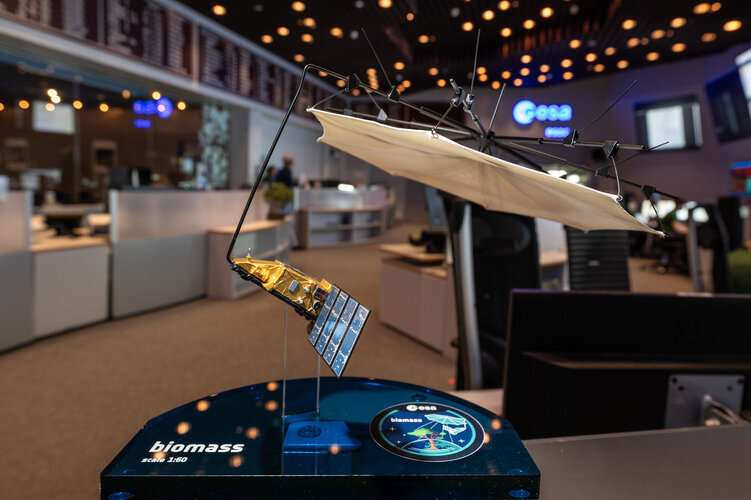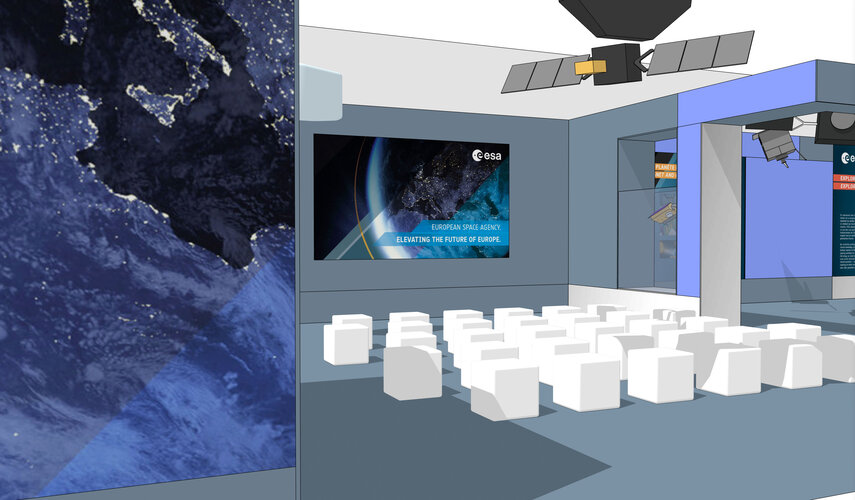
Copernical Team
Biomass completes a relay race of a LEOP

Mission control at ESA’s European Space Operations Centre has completed the critical Launch and Early Orbit Phase (LEOP) for ESA’s Biomass, after nine days of intense work.
Simulating space on Earth for miniature satellite testing
 Video:
00:00:33
Video:
00:00:33
Inside a spherical cagelike structure, a small platform slowly spins as if floating. A single, bright lamp illuminates the scene, simulating the Sun. This setup constitutes the European Space Agency’s brand new facility for the testing of CubeSats – small satellites, usually no larger than a shoebox and weighing only a few kilograms.
This space-simulating facility, built for ESA by University of Bologna and Nautilus - Navigation in Space, is part of the Attitude and Control System (AOCS) & Pointing Systems laboratory at ESTEC, the Agency’s technical centre.
Just like any piece of machinery destined for space, CubeSats undergo
What NASA Is Learning from the Biggest Geomagnetic Storm in 20 Years
 One year ago today, representatives from NASA and about 30 other U.S. government agencies gathered for a special meeting to simulate and address a threat looming in space. The threat was not an asteroid or aliens, but our very own life-giving Sun.
The inaugural Space Weather Tabletop Exercise was supposed to be a training event, where experts could work through the real-time ramifications
One year ago today, representatives from NASA and about 30 other U.S. government agencies gathered for a special meeting to simulate and address a threat looming in space. The threat was not an asteroid or aliens, but our very own life-giving Sun.
The inaugural Space Weather Tabletop Exercise was supposed to be a training event, where experts could work through the real-time ramifications Accelerating Mathematical Discovery with AI for Tomorrow's Breakthroughs
 Math has long been the engine behind countless technological advancements, but the path to groundbreaking mathematical insights has traditionally been slow and labor-intensive, often taking years or even centuries to unfold. This delay limits the ability of mathematics to tackle urgent challenges in fields like national security, medicine, and advanced computing.
To overcome this bottlenec
Math has long been the engine behind countless technological advancements, but the path to groundbreaking mathematical insights has traditionally been slow and labor-intensive, often taking years or even centuries to unfold. This delay limits the ability of mathematics to tackle urgent challenges in fields like national security, medicine, and advanced computing.
To overcome this bottlenec Save the date: 16–22 June - ESA at the Paris Air Show

The European Space Agency will be present at the 55th edition of International Paris Air Show, taking place on 16-22 June at Le Bourget airport.
Back to light

As the night closed in on Spain and Portugal on 28 April, polar satellites followed the blackout that lasted well into the early hours of the morning in several regions.
Webb reveals new details and mysteries in Jupiter’s aurora

The NASA/ESA/CSA James Webb Space Telescope has captured new details of the auroras on our Solar System’s largest planet. The dancing lights observed on Jupiter are hundreds of times brighter than those seen on Earth. With Webb’s advanced sensitivity, astronomers have studied the phenomena to better understand Jupiter’s magnetosphere.
SpaceX launches Starlink satellites from California, Florida over six hours
 SpaceX launched two batches of Starlink satellites aboard a Falcon 9 rocket in a little more than six hours late Friday and early Saturday from California and Florida.
First, the private agency launched 26 satellites to low Earth orbit at 5:19 p.m. PDT from Vandenberg Space Force Base pad 4E East in California. It was the 14th launch of this booster, including six previous Starlink miss
SpaceX launched two batches of Starlink satellites aboard a Falcon 9 rocket in a little more than six hours late Friday and early Saturday from California and Florida.
First, the private agency launched 26 satellites to low Earth orbit at 5:19 p.m. PDT from Vandenberg Space Force Base pad 4E East in California. It was the 14th launch of this booster, including six previous Starlink miss GMV Secures ESA Contract to Develop Advanced Orbital Neighborhood Monitoring Tool
 Operational collision avoidance (CA) traditionally covers a short window, typically up to two weeks into the future. However, this limited timeframe can leave satellite operators unprepared for sudden increases in collision risks outside this range, potentially leading to rapid escalations in operational workload. With the rapid growth in low Earth orbit (LEO) traffic, driven by the rise of larg
Operational collision avoidance (CA) traditionally covers a short window, typically up to two weeks into the future. However, this limited timeframe can leave satellite operators unprepared for sudden increases in collision risks outside this range, potentially leading to rapid escalations in operational workload. With the rapid growth in low Earth orbit (LEO) traffic, driven by the rise of larg Soviet-era spacecraft hits ocean after 50 years in orbit
 A Soviet-area spacecraft that orbited Earth for more than 50 years crashed into the Indian Ocean on Saturday, Russian officials confirmed.
"The Kosmos-482 spacecraft, launched in 1972, ceased to exist, deorbiting and falling into the Indian Ocean," the Russian State Space Corporation Roscosmos said on the cloud-based social media platform Telegram.
The spacecraft hit the ocean ar
A Soviet-area spacecraft that orbited Earth for more than 50 years crashed into the Indian Ocean on Saturday, Russian officials confirmed.
"The Kosmos-482 spacecraft, launched in 1972, ceased to exist, deorbiting and falling into the Indian Ocean," the Russian State Space Corporation Roscosmos said on the cloud-based social media platform Telegram.
The spacecraft hit the ocean ar 